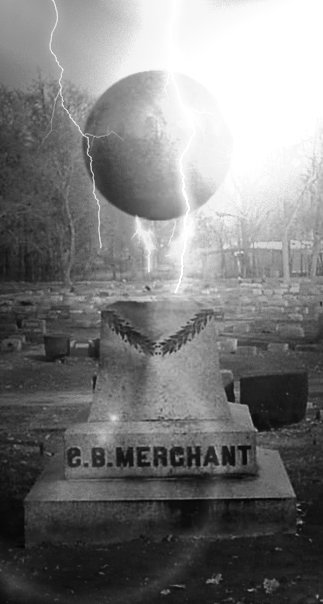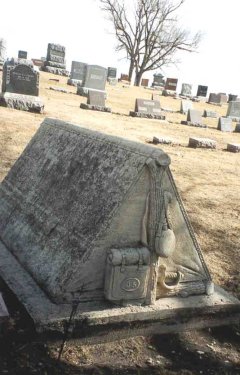
 |
|
|
In 1896 the Merchant family of Marion, Ohio erected what they thought would be a beautiful and fitting grave monument for their plot in the Marion Cemetery. Within two years after its installation, however, someone noticed that the 5,200 pound polished granite ball atop the Merchant pedestal had begun to rotate. The only unpolished spot on the ball was now visible indicating the ball was on the move. The Merchant family, being concerned about this, brought the erecting crew back to the site to re-set the ball. It was not long before the ball again began its now continuous movement. There have been many speculations, but there is no scientific explanation. In 1929 it was featured in "Ripley's Believe It or Not" famous newspaper cartoons and the monument soon gained international recognition. The Merchant Ball is located in the eastern section of Marion Cemetery in Marion, Ohio. Marion is about 30 minutes north of Columbus. Pretty strange, wouldn't you say? Now, scroll down and look at another photo of the same monument! |
This photo of the famous Merchant family monument was found by our friend Jose beneath a stairway as they were demolishing an old house in Marion. Instead of revolving, it would appear the ball is now levitating - with the assistance of some supernatural force? |
|
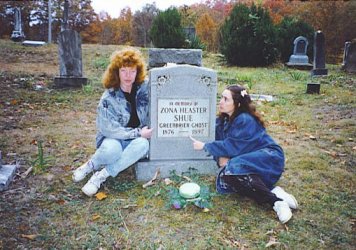 |
Our friend Rita found the gravestone of Zona Heaster Shue. Zona's death in 1897 was ruled natural by the authorities of the time. Then her ghost began appearing to her mother. The appartition insisted that she had been murdered by her husband, Edward Shue. Zona's mother persuaded the authorities to exhume Zona's body for the purpose of conducting an autopsy. The autopsy confirmed the account of the appartion. Edward Shue was convicted of murder and sentenced to state prison. |
|
From William: The last time I visited Iowa City, Iowa I went and saw one of the town’s most famous landmarks (besides the Old Capital and the University of Iowa campus). Located in Oakland Cemetery in Iowa City is the Feldevert Monument, which locals call the Black Angel. In 1911, Theresa Feldevert commissioned a monument for her teenage son Eddie and her husband Nicholas, who had both recently died. The 9 foot tall statue was originally white, but turned black shortly after being erected. Legend says that it turns a shade darker every Halloween. Also, it is said that the statue will kill anyone who touches it, except for virgins. People who have tried to deface the statue came down with strange ailments, which eventually killed them. The cold, angry look in the angel’s eyes really creeps me out, though I was told that a few moonlight weddings have been held there. |
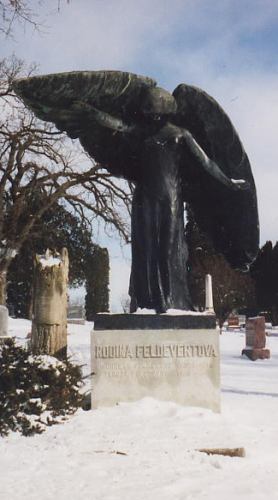 |
 |
From Bonni: This isn't particularly mysterious or anything, but it's one of the most beautiful headstone sculptures I've ever seen, and I've been in cemeteries throughout Europe and the United States, as well as here in Australia. This is in the Melbourne General Cemetery, in Melbourne, Victoria, Australia. It is the grave of an Irish immigrant named Michael Dawson. Since the man's name was Michael, I rather suspect that St. Michael (i.e., the Archangel Michael) was his patron saint. The statue is at least eight feet tall, and that doesn't include the pedestal. The sculpture was imported from Italy in the very early part of the 20th century (some time after Mr. Dawson died), at undoubtedly great cost. The beautiful but dangerous looking angel is a fine example of Italian art of the Art Noveau period. Personally, I think it would be wonderful to have a very large, armed, beautiful archangel to guard my grave! |
|
Our friend Tony Di Buono snapped this photo at Notre Dame Cemetery on Cote Des Neiges in Montreal. Notice the mist hanging in the air above the one grave and the bright area in the "midst of the mist" and just above it. This photo proves that not all apparations appear only at night - this photo ws taken on a bright, sunny day. |
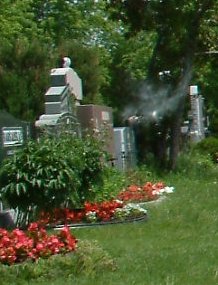 |
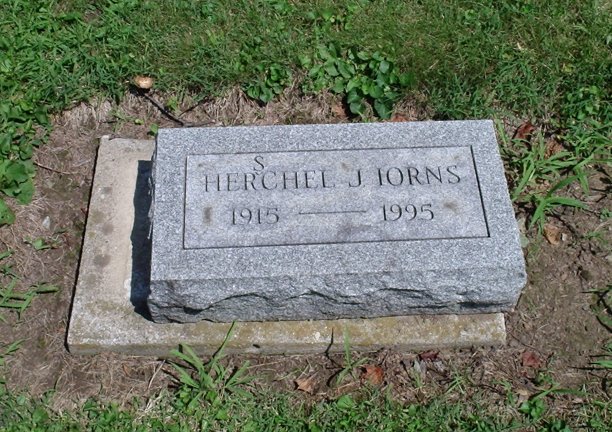 |
Our friend L. Duncan found this interesting gravestone while visiting a cemetery in Lebanon, Ohio. Note the spelling correction in the first name. |
|
Beth Santore took this photo at an old mental health hospital cemetery in Columbus, Ohio. This is one of two gravestones in the cemetery marked "specimens." Since all of the other gravestones in this particular cemetery are marked with name and dates of birth and death, Beth thinks perhaps the "specimen" graves contain cadavers used for medical training. It's an intriguing mystery. Who or what do you think might lie beneath this "specimens" headstone? |
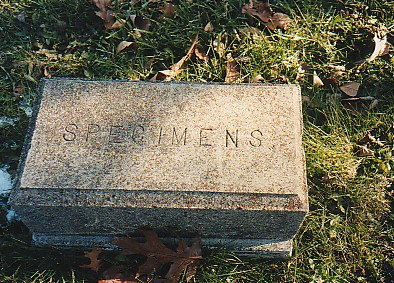 |
 |
Our friend GraveAddiction sent us this photo of the grave of Lizzie Whitlock, the original "fat lady" of the Barnum and Bailey Circus. She's buried in Batavia Township Michigan. We find it interesting, and very nice that, 103 years after her passing, someone still remembers to decorate her grave with a doll and flowers. |
|
Here's another fascinating photo sent in by our friend GraveAddiction. This is the grave of "Crissy the Skunk Woman" of Howe, Indiana. The "Skunk Woman" was an eccentric woman known for never bathing and for living in a dirt floor cabin with skunks for pets! She was often seen with her pet crow going to the swamps early in the morning and returning home late with a gunney sack full of . . . well, we'll really never know. Crissie's death was caused when the visiting nurses gave her her first bath. She contracted pnenonia and died three days later. |
 |
|
|
Lisa Barrientos found this interesting gravestone in a small cemetery in a small town in Iowa. She said the words have faded and can no longer be read. It would appear to be the gravestone of a Union Soldier from the War Between the States? Has anyone seen a similar Confederate gravestone? If so, snap a photo of it and we'll add it to this page. |
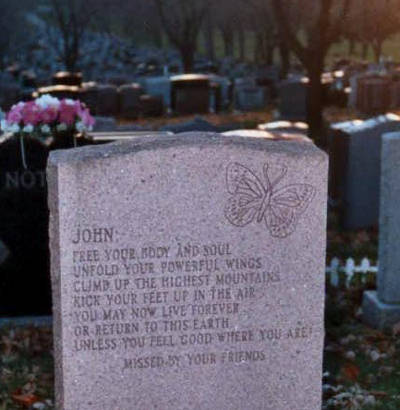 |
Here's an unusual monument sent in by Virginia Nelson. It's a bit difficult to read, so you have to look closely. A nice tribute by John's friends, eh? Not quite. Go back and look at the FIRST letter of each line - then read straight down. It would appear John's "friends" got the last laugh. |
|
|
|


